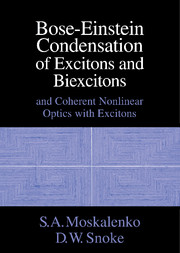Book contents
- Frontmatter
- Contents
- Preface
- 1 Introduction
- 2 Basic Theory of Bose–Einstein Condensation of Excitons
- 3 The Interaction of Condensed Excitons with Lattice Phonons
- 4 Bose–Einstein Condensation of Biexcitons
- 5 Phase Transitions and Thermodynamics of High-Density of Excitons
- 6 The Optical Stark Effect and the Virtual Bose Condensate
- 7 Bose–Einstein Condensation of Mixed States of Excitons and Photons
- 8 Nonequilibrium Kinetics of High-Density Excitons
- 9 Coherent Nonlinear Optics with Excitons
- 10 New Directions
- Appendix A: Properties of Excitons in Cu2O
- Author Index
- Subject Index
Appendix A: Properties of Excitons in Cu2O
Published online by Cambridge University Press: 04 August 2010
- Frontmatter
- Contents
- Preface
- 1 Introduction
- 2 Basic Theory of Bose–Einstein Condensation of Excitons
- 3 The Interaction of Condensed Excitons with Lattice Phonons
- 4 Bose–Einstein Condensation of Biexcitons
- 5 Phase Transitions and Thermodynamics of High-Density of Excitons
- 6 The Optical Stark Effect and the Virtual Bose Condensate
- 7 Bose–Einstein Condensation of Mixed States of Excitons and Photons
- 8 Nonequilibrium Kinetics of High-Density Excitons
- 9 Coherent Nonlinear Optics with Excitons
- 10 New Directions
- Appendix A: Properties of Excitons in Cu2O
- Author Index
- Subject Index
Summary
Because in many of the experiments discussed in this volume the semiconductor CU2O was used, and because this material is less well known than other semiconductors such as Si and GaAs, we review here some of the basic properties of CU2O.
CU2O is actually one of the earliest semiconductors studied [1], and the proof of the existence of excitons in this crystal [2, 3], which confirmed the theories of Frenkel [4], Wannier [5], and Mott [6], led to an exciting period of expansion in the field of excitonic physics in the late 1950s and early 1960s, during which time many of the optical properties of this intriguing crystal were established [7-19]. (For general reviews, see Refs. 20 and 21.) The same property that makes it an excellent material for nonlinear optical effects, namely, a very large excitonic binding energy (150 meV), makes it a poor electrical conductor even at room temperature. Therefore CU2O has not been studied or fabricated extensively by the electronics industry, and high-quality samples are still not widely available.
Band Structure. Most of the complexities of the band structure of CU2O stem from the d orbitals of the Cu atoms in the valence band. CU2O forms into a cubic lattice with inversion symmetry, which is the Oh symmetry group [22]. In the Oh symmetry, the five 3d orbitals are split by means of the crystal field into a higher threefold degenerate Γ+5 level and a lower twofold degenerate Γ+3level. The lowest conduction band, on the other hand, is formed from the 4s orbitals that have Γ+1 symmetry in the Oh group.
- Type
- Chapter
- Information
- Bose-Einstein Condensation of Excitons and BiexcitonsAnd Coherent Nonlinear Optics with Excitons, pp. 402 - 408Publisher: Cambridge University PressPrint publication year: 2000

